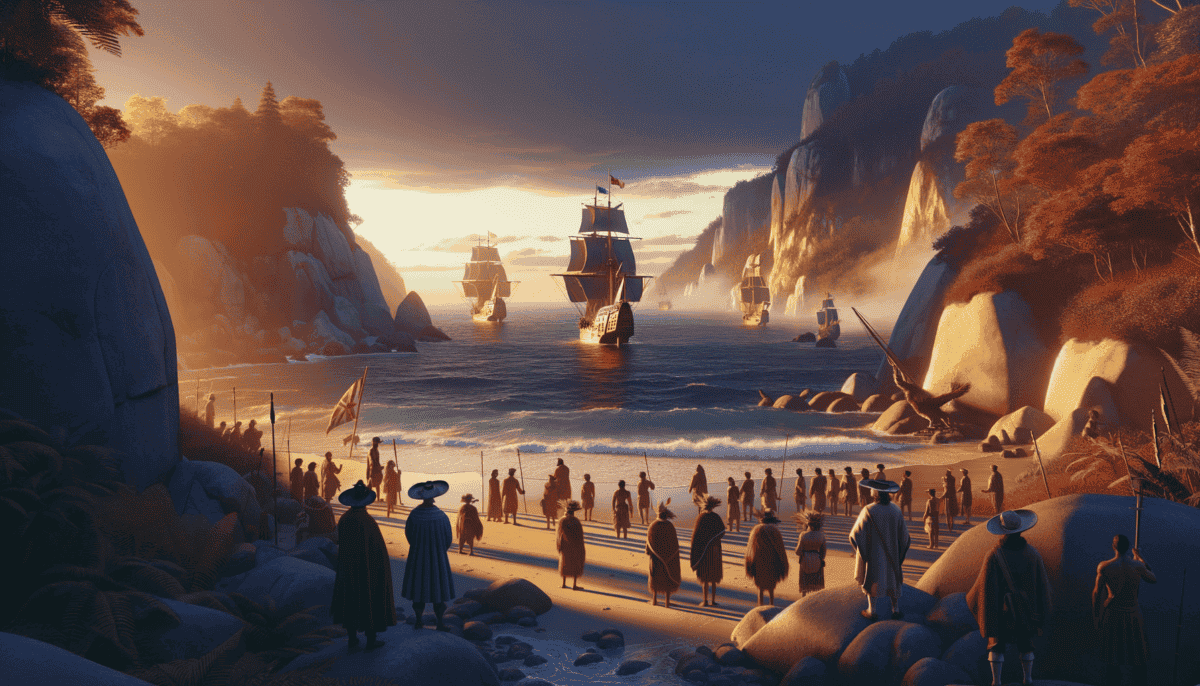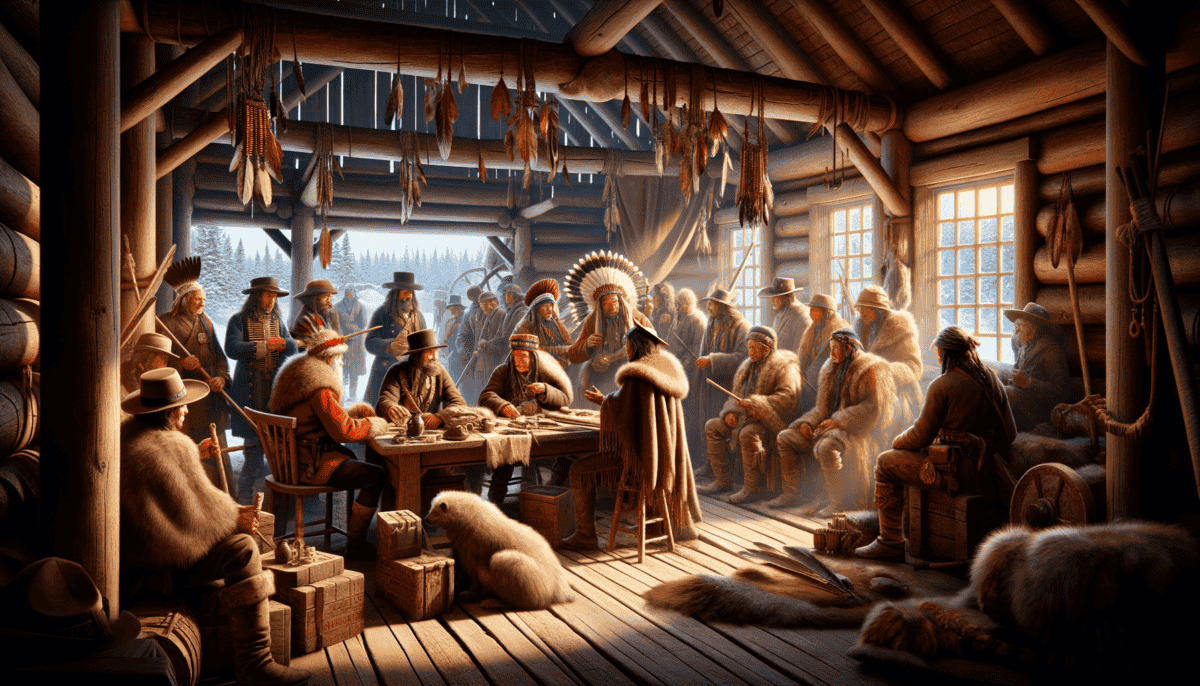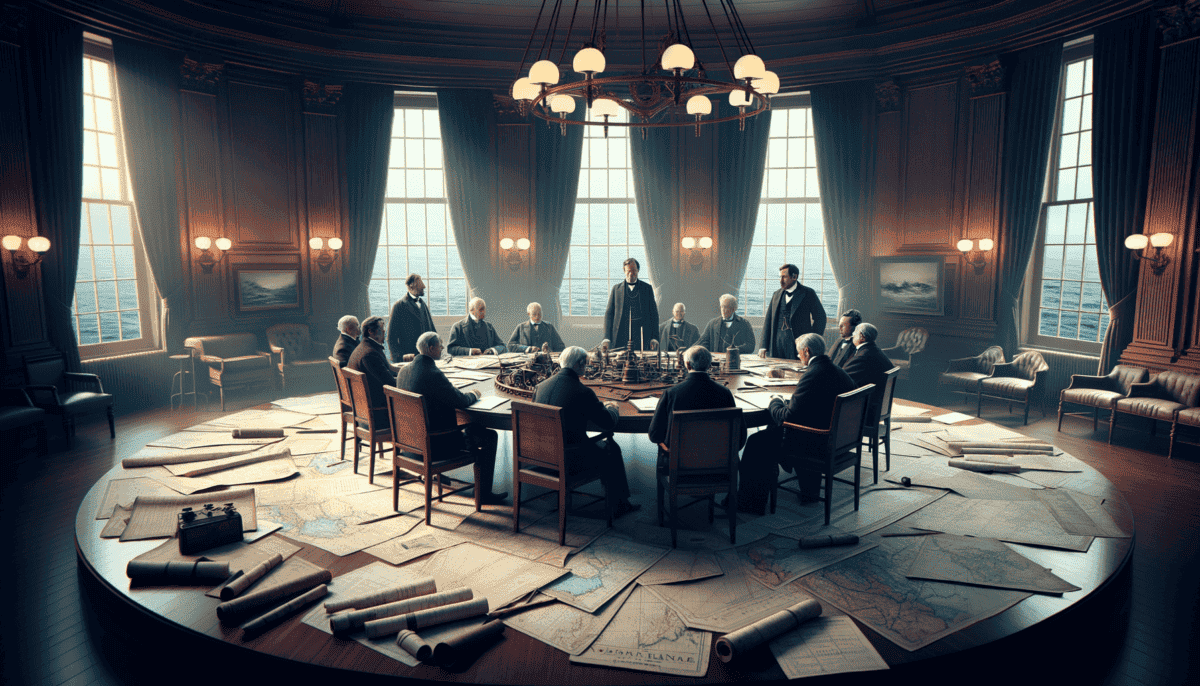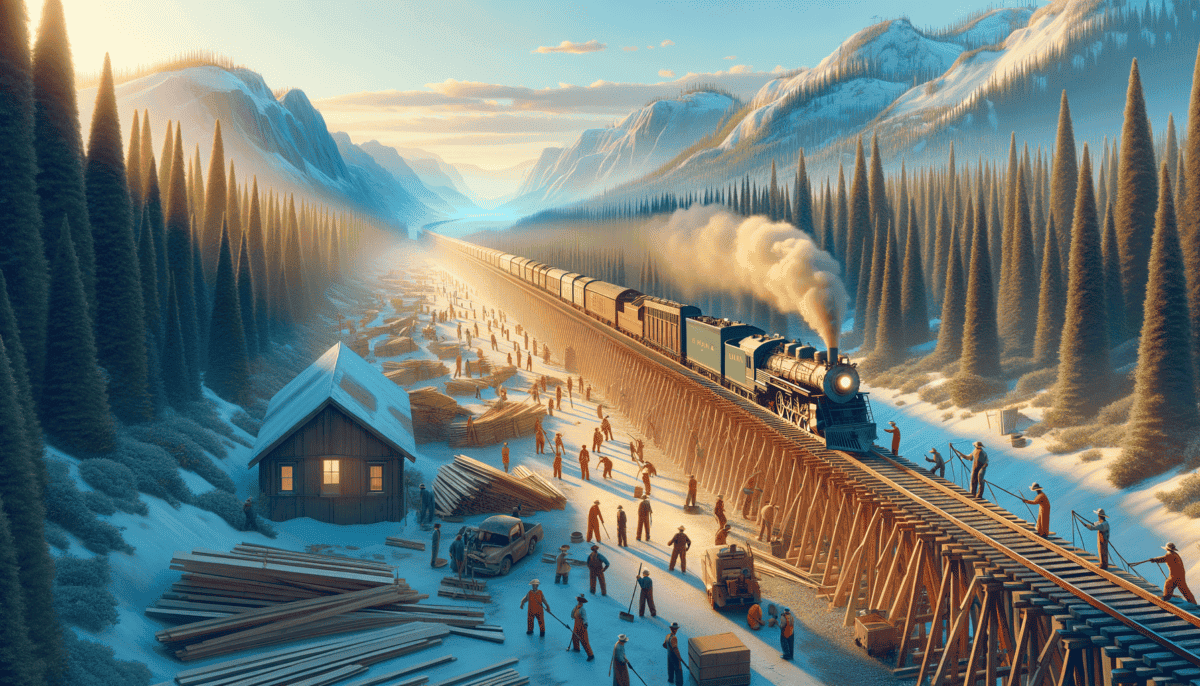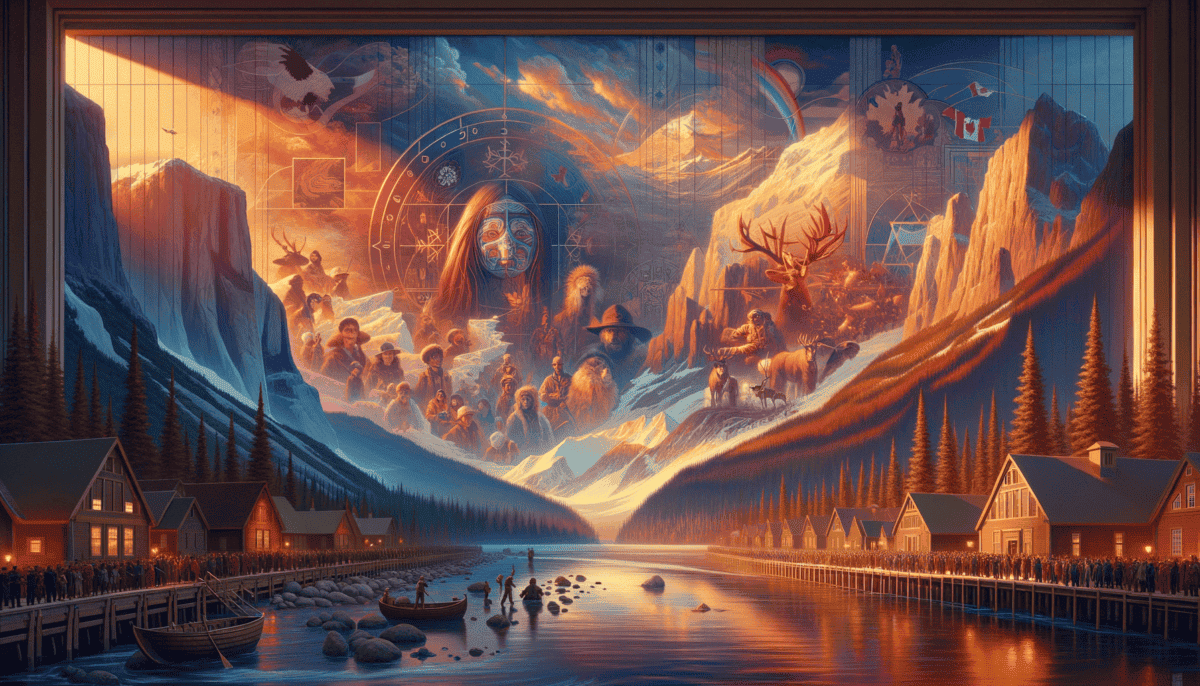The Land Before Time
Long ago, in a land of towering forests and sparkling lakes, the First Peoples of Canada lived in harmony with nature. The sun rose over vast territories where different Indigenous groups made their homes.
Little Bear watched as his grandmother, Morning Star, gathered sweet berries in her handwoven basket.
"Grandmother, tell me about our people," Little Bear said, helping her pick the juicy red berries.
Morning Star smiled warmly. “Our ancestors have lived on these lands since time began. Each nation has its own special stories and ways.”
• First Nations
• Inuit
• Métis
“In the cold northern lands,” Morning Star continued, “the Inuit people build homes from snow called igloos. They are very clever at hunting seals and fishing in the icy waters.” ❄️
Little Bear’s eyes widened. “And what about the people in the forests?”
“The First Nations peoples lived in different kinds of homes. Some built longhouses from wood and bark. Others made tipis that could be moved easily to follow the buffalo herds.”
“Our people know the land is precious. We only take what we need and give thanks to Mother Earth for her gifts.”
As they walked through the forest, Morning Star pointed out different plants. “This medicine plant helps with fever,” she explained. “And these leaves make good tea.”
The seasons guided their lives. In spring, they tapped maple trees for sweet syrup. Summer brought berry picking and fishing. Fall was time for hunting and gathering food for winter. During the cold months, they told stories and made beautiful crafts.
Little Bear learned about the special ceremonies that marked important times of the year. He loved the drumming and dancing that brought everyone together.
Traditional Ways of Life:
Some groups grew corn, beans, and squash.
Others followed caribou herds.
Coastal people caught salmon and gathered shellfish.
“Everything in nature is connected,” Morning Star said softly. “The trees, animals, water, and sky – they are all our relations. We must respect and protect them.”
As the sun began to set, Little Bear and his grandmother headed back to their village. The smell of cedar smoke from cooking fires filled the air, and he could hear children laughing as they played traditional games.
“Remember, Little Bear,” Morning Star said, “our ways are like the roots of a great tree. They run deep and keep us strong. Even as the world changes, we hold onto our traditions and stories.”
That night, as stars twinkled overhead, Little Bear thought about all he had learned. He felt proud to be part of such a rich culture that understood the importance of living in balance with nature.
Explorers and First Encounters
The salty breeze whipped across Jacques Cartier’s face as his ship sailed toward the mysterious new land. The year was 1534, and he was about to make history.
“Land ho!” shouted Pierre, the lookout from high above. Everyone rushed to the ship’s rail to see the rocky coastline ahead.
On shore, a group of Mi’kmaq people watched the strange ships approach. Their chief, Running Water, stood tall and proud.
“Look at their floating houses,” whispered a young girl to her mother. “They are as big as ten canoes!”
When Cartier’s crew landed, both groups stared at each other with curiosity. The Europeans wore heavy wool clothes and metal armor. The Mi’kmaq wore light deerskin clothing perfect for the woods.
“We come in peace,” Cartier said through hand signals. “We wish to trade.”
The Mi’kmaq showed the newcomers how to survive in this land. They taught them about:
• Which berries were safe to eat
• How to catch fish in the rivers
• Which trees made the best canoes
• Ways to stay warm in winter
Years later, another brave explorer named Samuel de Champlain arrived. He built a fort at a place called Quebec in 1608.
“This land is perfect for a settlement,” Champlain said to his crew. “The river is deep enough for our ships, and the hills will help us stay safe.”
Champlain made friends with the Huron-Wendat people. They showed him how to travel by canoe and survive the cold winters. ❄️
“Your boats are amazing,” said François, one of Champlain’s men, watching a group of skilled Indigenous paddlers. “They move like fish through the water!”
As more ships arrived from Europe, new trading posts appeared along the rivers and lakes. Maps started to show the shape of this vast land.
But not everything was peaceful. Sometimes there were fights over land and resources. The Europeans brought new sicknesses that made many Indigenous people very ill.
Still, this time of first meetings changed both the Indigenous peoples and the European explorers forever. They learned new things from each other and started sharing their different ways of life.
The stars that guided Cartier across the ocean now shone down on a changing land. New friendships formed, while old ways of life began to shift like the tides. The story of Canada was just beginning.
The Fur Trade Frontier
The morning sun sparkled on the river as Pierre, a young voyageur, loaded his canoe with beaver pelts. His arms were strong from months of paddling through Canada’s wild rivers.
“These furs will fetch a good price,” smiled Jean-Baptiste, his trading partner. “The English and French both want them badly.”
Miles away, in a cozy Indigenous village, Little Fox watched her father prepare beaver skins. She loved hearing the stories of the traders who came from far away.
“The fur trade has changed our lives,” her grandmother said, weaving a blanket. “Now we use metal pots and cloth from across the big water.”
Two big companies led the fur trade:
• Hudson’s Bay Company (The English Company)
• North West Company (The French Company)
Trading posts popped up like mushrooms across the land. They were busy places where people from different cultures met and shared stories.
“Welcome, friends!” called out Thomas, a Hudson’s Bay Company trader, as a group of Cree hunters approached his post. “What fine furs have you brought today?”
The traders learned many things from Indigenous peoples:
• How to travel by canoe
• Which animals had the best fur
• Ways to survive in the woods
• How to make warm clothes for winter
Many traders married Indigenous women. Their children became known as the Métis people, who had their own special culture.
“Watch how fast I can paddle!” laughed Marie, a young Métis girl, racing her canoe past the trading post. She was proud to know both her parents’ ways of life.
But life wasn’t always easy. The animals began to disappear from some areas because too many were being hunted. Some people got sick from new diseases.
“We must find a balance,” said Wise Eagle, an elder. “Take only what we need, so there will be animals for our children’s children.”
The fur trade brought many changes. New roads and paths appeared where traders traveled. People learned new languages to talk with each other. Different foods and clothes became popular.
As the sun set over the trading post, Pierre watched smoke rise from cooking fires. He heard French songs mix with Indigenous drumming. The smell of bannock bread filled the air.
This was a new Canada being born – where different peoples learned to live and work together, even though it wasn’t always easy. The fur trade had opened paths through the wilderness that would change the land forever.
Building a Nation’s Dream
Sarah stood at her window in Toronto, watching people hurry through the busy streets. The year was 1864, and big changes were coming to Canada.
“Papa, why are there so many important people in town?” she asked her father, who worked as a newspaper writer.
“They’re here to talk about making Canada into one big country,” he explained. “Right now, we’re just separate colonies.”
John A. Macdonald walked down the street, his red hair bright in the sun. He had a big dream – to join all the separate parts of Canada into one nation.
“We need to work together!” Macdonald told the crowd gathered in the town square. “United, we can build something amazing!”
In Quebec, George-Étienne Cartier agreed. He wanted French-speaking and English-speaking people to share one country. But not everyone liked this idea.
“What about our different ways of living?” worried Marie from Nova Scotia. “Will we still get to keep our special traditions?”
The leaders worked hard to solve problems:
• How to make rules that were fair for everyone
• How to share money between different areas
• How to protect both French and English languages
• How to connect far-away places
Little Tommy watched the meetings from the doorway of his father’s shop. “It’s like watching history happen!” he whispered to his friend Emma.
Finally, after many long talks and arguments, they made a plan. On July 1, 1867, Canada became one country! People celebrated in the streets with music and fireworks.
“We did it!” cheered Macdonald, who became Canada’s first Prime Minister. “But our work is just beginning.”
Sarah wrote in her diary that night: “Today, we became something new and wonderful – we became Canadians!”
But not everything was perfect. Some people felt left out of the big decisions. Indigenous peoples weren’t asked what they thought about the new country being built on their land.
“We must remember everyone’s stories,” Sarah’s grandmother told her. “That’s how we’ll build a country that’s fair for all.”
The new Canada was like a baby learning to walk. Sometimes it stumbled, but it kept trying to grow stronger. People from Ontario to Nova Scotia were now part of the same big family.
As night fell over the new country, Sarah looked at the stars. She wondered what adventures tomorrow would bring. Canada was growing up, and everyone had a part to play in its story.
The dream of building one nation was coming true, but there were still many chapters left to write in Canada’s story.
The Iron Road to Unity
The morning sun sparkled on the railway tracks as Tommy watched workers hammer the heavy steel rails. It was 1881, and Canada was building something amazing – a railway that would connect the whole country!
“This railway will be like a giant string that ties Canada together,” explained Mr. Van Horne, who was in charge of building it.
Little May pressed her ear against a rail. “I can feel the earth shaking from all the work!” she giggled. Thousands of workers were laying tracks across Canada, from the Atlantic Ocean to the Pacific Ocean.
“It’s not easy work,” said Chen, whose father was helping build the railway. Many workers came from China to help. They worked very hard in dangerous places, especially in the Rocky Mountains. ️
Sarah, now grown up, wrote stories about the railway for her newspaper:
• Workers digging through mountains
• Building bridges over deep valleys
• Fighting through snow and rain
• Laying tracks across wide prairies
“Why is this railway so important?” asked Tommy’s little sister Emma.
“Because right now, it takes months to travel across Canada,” Tommy explained. “With the railway, it will only take days!”
New towns popped up along the tracks like flowers in spring. People moved west to farm the prairies, bringing their hopes and dreams with them.
“Look!” shouted Chen one morning. “More families are coming!” A train full of new settlers pulled into the station, their faces pressed against the windows in excitement.
But building the railway was hard. Some days were so cold that the tools would stick to workers’ hands. Other times, they had to use dynamite to blast through mountains.
“We must keep going,” said Mr. Van Horne. “This railway will make Canada stronger.”
Finally, on November 7, 1885, something special happened. At a place called Craigellachie, workers put in the last spike – and it was made of gold! ✨
Donald Smith, one of the railway’s leaders, swung his hammer. CLANG! The golden spike connected the final rails. People cheered and threw their hats in the air!
“Now we can travel from sea to sea on Canadian rails!” Tommy danced with joy. He dreamed of riding the train across the whole country someday.
The railway brought more than just trains. It brought mail, food, and new friends from far away. It helped Canada grow into a bigger, stronger country.
That night, Sarah wrote in her diary: “Today, Canada feels more like one big family than ever before. The railway is like a magic thread that sews our huge country together.”
As the sun set, the new railway stretched into the distance like a shining path to tomorrow. Canada was changing, growing, and moving forward – all thanks to the iron road that connected its heart.
A Nation United and Strong
Sarah stood at the Peace Tower in Ottawa, watching the Canadian flag wave proudly in the breeze. It was 2023, and Canada had grown into an amazing country that welcomed people from all over the world.
“Canada is like a big, colorful quilt,” Sarah told her granddaughter Maya. “Each piece is different and special, but together they make something beautiful.”
Maya’s class had just finished learning about Canada’s role in helping other countries during hard times. “Grandma, tell me about when Canada became known as peacekeepers!” she asked excitedly. ️
“Well,” Sarah smiled, “Canada showed the world that being strong doesn’t always mean using force. Sometimes it means helping others find peaceful solutions.”
Looking around Parliament Hill, Maya saw people from many different backgrounds:
• Students speaking different languages
• Families wearing traditional clothes
• Musicians playing various instruments
• People sharing foods from their cultures
“Our country is special because everyone can feel at home here,” Maya said proudly. “My best friend Aisha just moved from Syria, and now she’s teaching me Arabic!”
The streets buzzed with excitement as people celebrated Canada Day. Children with painted faces waved flags, and the smell of poutine and maple syrup filled the air.
“Things weren’t always perfect,” Sarah explained. “We made mistakes along the way. But we learned from them and tried to make things better.”
Maya thought about her Indigenous friend Jenny, who taught her about pow wows and traditional medicines. “We’re still learning to listen to everyone’s stories, aren’t we?” she asked thoughtfully.
“That’s right,” Sarah nodded. “Every Canadian’s story is important – from the First Peoples who lived here long ago to the newest family that arrived yesterday.” ❤️
Just then, a group of young scientists walked by, talking excitedly about new ways to protect nature. “Canada is also a leader in taking care of our environment,” Sarah explained.
“Look, Grandma!” Maya pointed to a sculpture showing hands of different colors joined together. “That’s what makes Canada strong – we help each other!”
As the sun began to set, the Parliament buildings lit up in beautiful colors. Maya watched as people gathered for an evening concert on the lawn.
“You know what?” Maya said, hugging her grandmother. “I think the best part of Canada’s story is that it’s still being written – by all of us, together.”
Sarah smiled, remembering the long journey from the first Indigenous peoples to the railway that united the land, and now to this moment. “And what a wonderful story it is,” she whispered.
The evening stars twinkled above as families gathered to watch fireworks paint the sky. In cities and towns across the country, Canadians celebrated their shared home – a place where dreams could grow as tall as the Rocky Mountains and hearts could be as wide as the prairies.
And as Maya looked up at the sparkling sky, she knew that Canada’s greatest adventures were still to come. This was not just the end of one story, but the beginning of many more – all woven together in the tapestry of a nation that stood strong, proud, and free.


